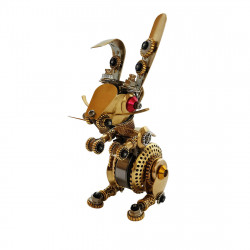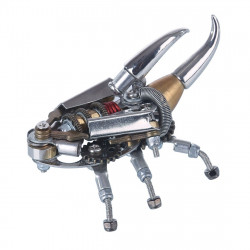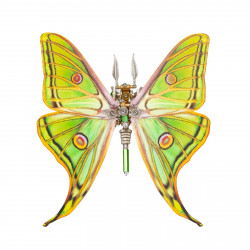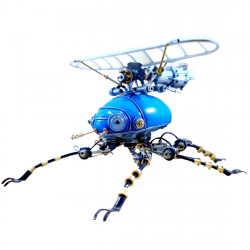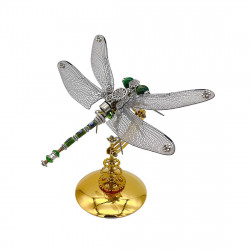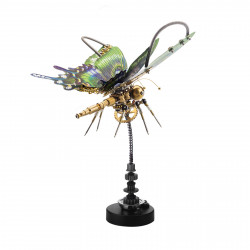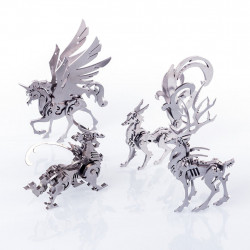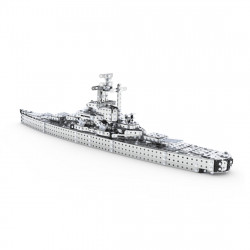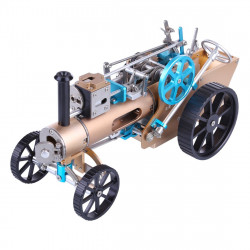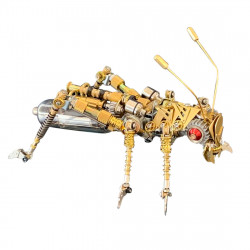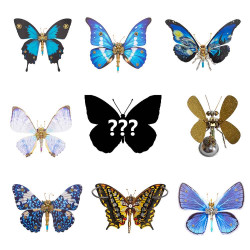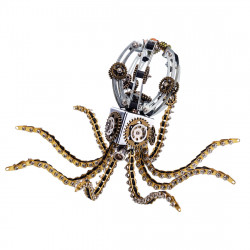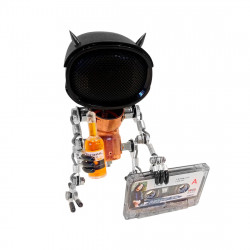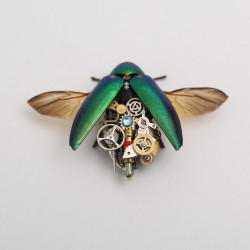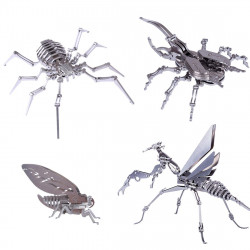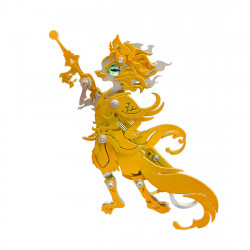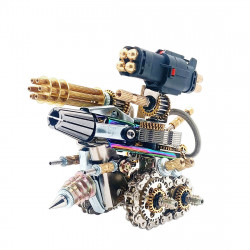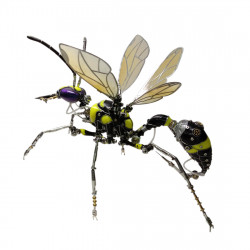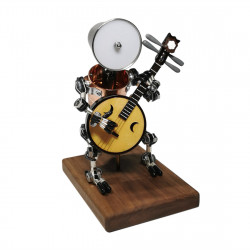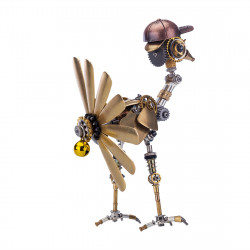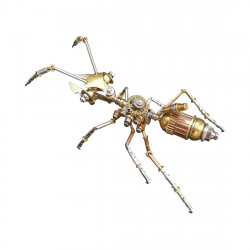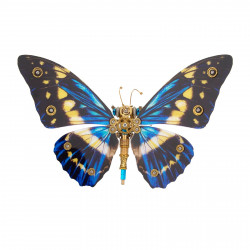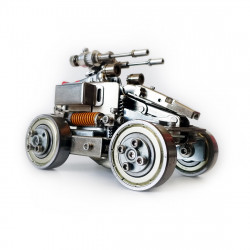Save the Seahorse - Steampunk Seahorse

Save the Seahorse - Steampunk Seahorse
Seahorse Family Story
The fish in the Syngnathidae family are collectively referred to as seahorses. The word "hippocampus" is derived from the Ancient Greek hippókampos, a sea monster resembling a horse. Híppos means "horse," and kámpos means "sea monster" or "sea animal." The seahorse was referred to as the horse of the sea god in ancient Greek mythology, where the term originated.
As of now, there are 42 known species of seahorses worldwide (although over six dozen are still up for debate). China has the most species of seahorses, with 14, making up one-third of the world's total count. These seahorses come in many different sizes and shapes.
A horse-like head, fins (which are a common feature of fish, though only the dorsal and pectoral fins are more developed), a tail for grasping objects like a New World monkey, and—most oddly—the male seahorse's brood pouch are some of the morphological similarities shared by all seahorses. As a result, the sea horse is unquestionably the "four unlike" in the water.
The most recognizable feature is the seahorse's head. Some seahorse species feature a unicorn-like nose with spines between each nostril and a pair of eye spines above the eyes, in addition to having a straw-like snout, a crown on top of the head, and buccal spines on either side of the cheek. These traits, which differ from species to species, are frequently employed as a rapid method of species identification.
How big is a seahorse?
The image above is a fake, so don't be deceived. The largest seahorse species, such as H. Abdominalis and H. Kelloggi, are found across China and are considered "tall, rich, and handsome" in the seahorse family. However, they can only reach a maximum size of 35 cm.
But there are also adorable and tiny seahorse species, such as H. Bargibanti, which typically reach an adult size of no more than 2 cm. Because of this, they are now the main attraction for divers and macrophotographers.
They've been on Earth for 20 million years.
Seahorses originated in waters ranging from present-day Southeast Asia to Northern Australia over 30 to 20 million years ago. The group of fishes known as "Idiotropiscis" in the Syngnathidae family is the closest relative of the seahorse. The primary distinction between the two groups is that although the Idiotropiscis cannot be significantly twisted, seahorses' heads and trunks can. Idiotropiscis are prone, whereas seahorses are upright.
They have five special powers.
There is a proverb that states, "A sparrow may be small but all its vital organs are there." Seahorses have some little-known traits in addition to their odd look.
Seahorses that are males become pregnant and give birth. It is unlike anything found in nature. A brood pouch resembling a mammalian uterus is located between the male horse's belly and tail. It functions better than a kangaroo's pouch, giving infants food and a haven. It is unclear why this is the case. In jest, perhaps God felt that it would be unjust if all of the women in the world were in charge of bearing children. Seahorses are so unique because of this.
Seahorses can blend well with their surroundings. While some seahorses specialize in sarcomatoid spines like gorgonians, others have filaments that resemble algae. They disguise themselves for deep lurk by mimicking the contours of their environment.
Like chameleons, seahorses can move their left and right eyes independently. Because of their 360° panoramic vision, they can monitor zooplankton passing by with one eye while keeping the other alert for potential predators.
The tails of seahorses are highly flexible. Because of its square cross-section, the seahorse's tail offers excellent protection and flexibility. Mechanical engineering researchers have found that the seahorse's tail, which has developed over tens of millions of years, is highly flexible and, thanks to the ideal synchronization of exterior bone and muscle tissue, protects the internal spine—the discovery motivated engineers who create and construct robotic arms and robots.
They get bullied by a lot of sea animals
The most endangered species in the water is the seahorse. Due to their varying mouth opening sizes and nutritional requirements, their prey changes as they grow and develop. They feed on small zooplankton, including copepods, shrimp, and cladophora.
Many marine species, such as turtles, cormorants, rays, sardines, and even lowly invertebrates like crabs, shells, and sea urchins, prey on seahorses due to their poor swimming abilities and weak defences.
Seahorses have three distinct defence mechanisms against predators: hiding, feigning death, and clinging legs. These defences help them escape being harassed and devoured. Look, they're intelligent.
Seahorses are the most devoted fish in the world.
Seahorses have unusual and intricate mating patterns and habits, and they are typically exclusively monogamous, in contrast to most fish seen in nature.
First, it is difficult for an adult seahorse to find a good mate because they are naturally sparsely scattered, with fewer than tens in a 100x100m region. Adult seahorses of similar size will "dance" together and unite if they encounter each other in the wild. They met daily for the following week or two at the exact location, generally in the early morning or late afternoon when the moon began to show.
The male and female seahorse may "dance" together in a peaceful environment, sometimes with their tails intertwined like human hands, which is incredibly sweet and humorous. Following their relationship, the female seahorse releases eggs into her pouch, fertilizing them and growing into young. She then swims into the water at the appropriate moment to mate.
The male gives birth to his pups between 9 and 45 days after conception. Only a small portion of the 2–2,000 puppies that typically comprise a litter survive adulthood.
Destined to roam since birth
Typically the size of a mosquito, newborn seahorse pups begin to live independently. They move with the sea to new habitats during 2 to 8 weeks of birth.
During this process, they will "clump together" and use their tails to capture part of the seaweed in the water layer. In addition to saving energy (since they are still not very good swimmers), they also deceive predators by hitchhiking. Even so, a significant portion of the puppies either die from starvation or are consumed by other creatures (tuna, cormorants, penguins, turtles, etc.) while they are floating.
What does the disappearance of seahorses mean?
Because seahorses have high standards for environmental quality, they only inhabit sea locations with notable water quality and comparatively complex and healthy habitats, such as estuaries and lakes with good water quality, seaweed beds, mangroves, and coral communities.
The H. coronatus, a species of seahorse that only inhabits temperate waters and is named for its well-developed crest, is a prime example. It was discovered in the Bohai Sea and was first documented in China at the close of the previous century ("Bohai Sea Fish Records" in 1994). However, no trustworthy source has confirmed that it was discovered once more in the last ten years, which is probably strongly linked to overfishing and marine pollution in the Bohai Sea. The decline of the marine environment is brought to light by the extinction of seahorses.
The status of the seahorse population is worrying.
The seahorse family faces a serious threat from overfishing, mostly from bottom trawling and environmental degradation because of their low natural reproduction and difficult ecological conditions.
Currently, 14 seahorses are listed as endangered by the International Union for Conservation of Nature (IUCN). As the first marine fish to be put on Appendix II of the Convention on International Trade in Endangered Species of Wild Fauna and Flora (CITES), seahorses were formally designated subject to stringent international trade prohibitions in 2004.
The seahorse is a type of fish that lives in the sea and is named because it resembles a horse; however, it is not a horse. The classification of seahorses is still up for debate globally today. Seahorse is the common name for the species of Syngnathiformes Syngnathidae Hippocampus, according to the classification scheme used by CITES. The IUCN lists 46 species of seahorses, which are found in both temperate and tropical waters.
The male seahorse's ventral or brood pouch is where females lay their eggs during the breeding season. The male seahorse fertilizes the egg by releasing sperm after obtaining it, and the fertilized egg is then incubated for 15 to 30 days. There are many blood arteries in the pouch, which supply nutrients for the fertilized egg to hatch. The male releases the pups from the pouch as soon as they hatch.
That being said, this is the reason behind the creation of the Steampunk Seahorse Model Kit.


